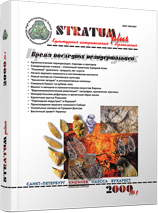Проблемы карпатского мустье в Румынии
Problems of the Carpathian Mousterian in Romania
Author(s): Marin CârciumaruSubject(s): History, Archaeology
Published by: Издательский дом Stratum, Университет «Высшая антропологическая школа»
Keywords: Carpathian Mousterian; Romania; cultural groups;
Summary/Abstract: Mousterian sites wide spread in Romania tell of a large variety of cultural groups. One can say now that they were formed both on basis of the local Palaeolithic traditions and as result of contacts between big societies of Mousterian epoch, widely represented on other European territories. It was, probably, a consequence of mobility of the people of that epoch and an active search for the best technology that would enable the man to adapt to the various environmental conditions. One can expect that the technical diversity of the Romanian Mousterian is connected with a bulk of various factors typical for this or another microzone, and distinguished by peculiarities of climatic and/or local resources. At present, given technical and typological peculiarity of tools (ratio of flakes, blades and bifacials), chronology and nature of the material used, part of Mousterian sites in Romania, in particular, upper assemblages of the Carpathian grottoes Curata, Bordul Mare, Gura Cheii, Spurcata and Hotilor, earlier groundlessly attributed to the typical Mousterian, were actually developing at the same time with the phases of Mitoc-on-Prut type, Selet and Pre-Solutrean type in Central Europe. This means that the upper assemblages of the Carpathian grottoes in Romania, synchronous with Ohaba Interstadial and with preceding glacial stage, can be compared with the transition period to the Upper Palaeolithic and can be determined as a separate phase, characteristic for the Southern Carpathians. Distinction of this Carpathian phase is facilitated because the local types of stone are predominant among the tools from the monuments/sites representing it (quartzite, diorite, etc.), as well as because of the expressiveness of leaf points and bifacials.
Journal: Stratum plus. Археология и культурная антропология
- Issue Year: 2000
- Issue No: 1
- Page Range: 351-367
- Page Count: 17
- Language: Russian
- Content File-PDF

